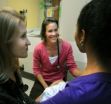(Press-News.org) This press release is available in German.
The immune system is comprised of multiple cell types each capable of specialized functions to protect the body from invading pathogens and promote tissue repair after injury. One cell type, known as monocytes, circulates throughout the organism in the blood and enters tissues to actively phagocytose (eat!) foreign cells and assist in tissue healing. While monocytes can freely enter most bodily tissues, the healthy, normal brain is different as it is sequestered from circulating blood by a tight network of cells known as the blood brain barrier. Thus, the brain must maintain a highly specialized, resident immune cell, known as microglia, to remove harmful invaders and respond to tissue damage.
In certain situations, such as during disease, monocytes can enter the brain and also contribute to tissue repair or disease progression. However, the potential for monocytes to actively replace old or injured microglia is under considerable debate. To address this, Nicholas Varvel, Stefan Grathwohl and colleagues from the German Center for Neurodegenerative Diseases (DZNE) Tübingen and the Hertie Institute for Clinical Brain Research in Tübingen used a transgenic mouse model in which almost all brain microglia cells (>95%) can be removed within two weeks. This was done by introducing a so-called suicide gene into microglia cells and administering a pharmaceutical agent that leads to acute death of the cells. Surprisingly, after the ablation of the microglia, the brain was rapidly repopulated by blood-circulating monocytes. The monocytes appeared similar, but not identical to resident microglia. The newly populated monocytes, evenly dispersed throughout the brain, responded to acute neuronal injury and other stimuli — all activities normally assumed by microglia. Most interestingly, the monocytes were still present in the brain six months - nearly a quarter of the life of a laboratory mouse - after initial colonization.
These studies now published in PNAS provide evidence that blood-circulating monocytes can replace brain resident microglia and take over the essential immune surveillance of the brain. Furthermore, the findings highlight a strong homeostatic mechanism to maintain a resident immune cell within the brain. The observation that the monocytes took up long-term residence in the brain raises the possibility that these cells can be utilized to deliver therapeutic agents into the diseased brain or replace microglia when they become dysfunctional. Can monocytes be exploited to combat the consequences of Alzheimer's disease and other neurodegenerative diseases? The scientists and their colleagues in the research groups headed by Mathias Jucker are now following exactly this research avenue.
### Original publication:
"Microglial repopulation model reveals a robust homeostatic process for replacing CNS myeloid cells", Nicholas H. Varvel, Stefan A. Grathwohl, Frank Baumann, Christian Liebig, Andrea Bosch, Bianca Brawek, Dietmar R. Thald, Israel F. Charo, Frank L. Heppnerf, Adriano Aguzzi, Olga Garaschuk, Richard M. Ransohoff, and Mathias Jucker, Proceedings of the National Academy of Sciences (PNAS): www.pnas.org/cgi/doi/10.1073/pnas.1210150109
Immune cells of the blood might replace dysfunctional brain cells
2012-10-22
ELSE PRESS RELEASES FROM THIS DATE:
Mock clinical exams boost pediatric residents' comfort in addressing breastfeeding
2012-10-22
AUGUSTA, Ga. – A simulated clinical experience guiding future pediatricians through interactions with breastfeeding moms appears to put the doctors at ease with the sensitive and important health topic, researchers say.
"We showed that their confidence and comfort increased with the OSCE (Objective Structured Clinical Examination) interventions," said Dr. Kathryn McLeod, a pediatrician and educator at the Medical College of Georgia at Georgia Health Sciences University who developed the three simulated patient exams.
Breastfeeding education typically falls to pediatricians ...
Gastric bypass surgery just as effective in teenagers as in adults
2012-10-22
Teenagers with severe obesity can benefit from gastric bypass surgery just as much as adults. A study by Sahlgrenska Academy, University of Gothenburg, Sweden and Karolinska Institutet, Sweden found that 81 teenagers lost an average of 96.8 pounds following surgery, significantly improving their health and quality of life.
The study, published by the International Journal of Obesity, involved eighty-one 13-18 year-olds who had gastric bypass surgery, which had previously been performed on people younger than 18 in exceptional cases only.
The new study found that gastric ...
Want the shortest path to the good life? Try cynicism
2012-10-22
Are cynics and happiness mutually exclusive? For modern cynics, perhaps. But for the ancient Cynics, not necessarily.
Research by the University of Cincinnati's Susan Prince shows that despite the historical perception of the ancient Cynics as harsh, street-corner prophets relentlessly condemning all passersby and decrying society's lack of virtue, these Greek philosophers, indirectly descended from Socratic teaching, weren't all doom and gloom. They actually might have espoused a shortcut to happiness.
"We don't have good scholarship on the Cynics. They're seen as ...
Rejecting arsentate
2012-10-22
Not long ago, some unassuming bacteria found themselves at the center of a scientific controversy: A group claimed that these microorganisms, which live in an environment that is rich in the arsenic-based compound arsenate, could take up that arsenate and use it – instead of the phosphate that all known life on Earth depends on. The claim, since disproved, raised another question: How do organisms living with arsenate pick and choose the right substance?
Chemically, arsenate is nearly indistinguishable from phosphate. Prof. Dan Tawfik of the Biological Chemistry Department ...
3D structure of an unmodified G protein-coupled receptor in its natural habitat
2012-10-22
Scientists have determined the three-dimensional structure of a complete, unmodified G-protein-coupled receptor in its native environment: embedded in a membrane in physiological conditions.
Using NMR spectroscopy, the team mapped the arrangement of atoms in a protein called CXCR1, which detects the inflammatory signal interleukin 8 and, through a G protein located inside the cell, triggers a cascade of events that can mobilize immune cells, for example.
Because G protein-coupled receptors are critical for many cellular responses to external signals, they have been ...
Stem cell bodyguards
2012-10-22
Hiding deep inside the bone marrow are special cells. They wait patiently for the hour of need, at which point these blood forming stem cells can proliferate and differentiate into billions of mature blood immune cells to help the body cope with infection, for example, or extra red blood cells for low oxygen levels at high altitudes. Even in emergencies, however, the body keeps to a long-term plan: It maintains a reserve of undifferentiated stem cells for future needs and crises. A research team headed by Prof. Tsvee Lapidot of the Institute's immunology Department recently ...
Alarming increase in malignant melanoma on the west coast of Sweden
2012-10-22
Malignant melanoma is as much as 35% more common among people who live in Gothenburg and the region's coastal municipalities than those who live inland. Researchers at Sahlgrenska Academy, University of Gothenburg, Sweden, have found that the number of malignant melanoma cases in the Västra Götaland region has quadrupled since 1970.
Malignant melanoma has become increasingly common in the Western world over the past few decades. One of the biggest factors has been excessive and unprotected sunbathing despite widespread awareness of the health risks.
Melanoma takes a ...
Immune cells make flexible choices
2012-10-22
Our immune system must be tremendously complex to respond to the unending assault of viruses, bacteria and cancerous cells. One of the mechanisms used by the immune system to cope with the huge variety of possible threats is to randomly combine DNA segments for the production of receptors on lymphocytes – a type of white blood cell. The number of possible receptors that can be produced in this way is about 1000 times the number of stars in our galaxy – one followed by 15 zeroes. And yet, the actual array of receptors produced does not conform to this picture of random chance: ...
One-third of parents concerned about losing jobs, pay when they stay home with sick kids
2012-10-22
ANN ARBOR, Mich. – Many child care providers have rules that exclude sick children from care, spurring anxious moments for millions of working parents. In a new University of Michigan poll, one-third of parents of young children report they are concerned about losing jobs or pay when they stay home to care for sick children who can't attend child care.
The University of Michigan C.S. Mott Children's Hospital National Poll on Children's Health recently asked parents who have children younger than six years old in child care about the impact of child care illness on their ...
Kittens: Their microbiomes are what they eat
2012-10-22
URBANA – For animals as well as people, diet affects what grows in the gut. The gut microbial colonies, also known as the gut microbiome, begin to form at birth. Their composition affects how the immune system develops and is linked to the later onset of metabolic diseases such as obesity.
Common wisdom is that cats, by nature carnivorous, are healthiest when fed high-protein diets. Researchers at the University of Illinois wanted to find out if this is true.
"There are a lot of diets now, all natural, that have high protein and fat and not much dietary fiber or carbohydrates," ...

